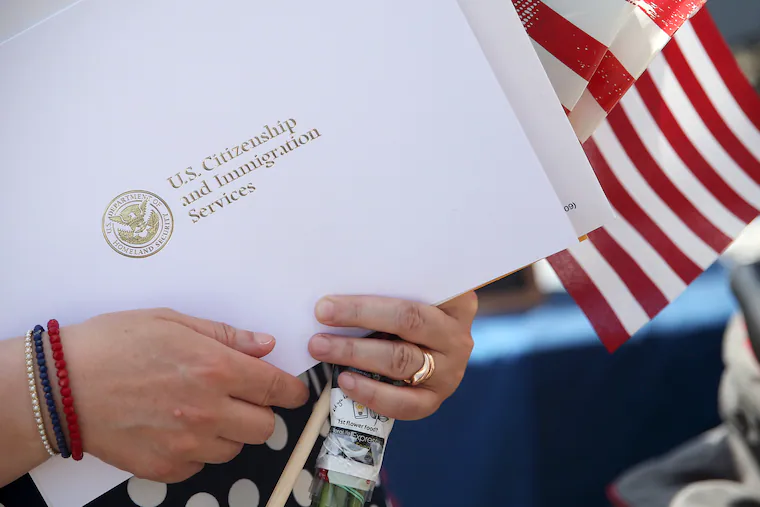14 million undocumented immigrants live in the U.S. Getting legal status is harder than you think.

The question keeps being asked about immigrants who are living in the United States without permission:
Why don’t they just get in line for legal status?
The answer: There is no line. Not for most people.
This month the American Immigration Council issued an explainer on why it’s so hard for undocumented immigrants to adjust their status, and how that has become even more difficult as President Donald Trump toughens regulations and works to deport millions of people.
Here are answers to some of the most commonly asked questions on the topic.
Can people in other nations legally move here and start new lives if they wish?
Generally, no. There are three main ways to lawfully, permanently immigrate to the United States ― for work, to reunify family, or for humanitarian protection. Would-be immigrants who fall outside those categories, or who cannot meet the strict regulations within them, generally can’t settle here.
The Cato Institute, a Libertarian research organization in Washington, D.C., says lawfully immigrating to the United States is “nearly impossible,” and fewer than 1% of those who want to move here can do so.
“Legal immigration is less like waiting in line and more like winning the lottery,” the institute said in a 2023 study. “It happens, but it is so rare that it is irrational to expect it in any individual case.”
Hasn’t the U.S. been a beacon for immigrants?
Yes. But not always. And definitely not now.
Since its beginnings, America has had an ambivalent relationship with immigration. Benjamin Franklin, an immigrant from England, disliked immigrants from Germany. He warned in a pamphlet against allowing those of “swarthy complexion” to come here.
Today, when people say, “My ancestors came legally” what they’re saying is their people came when immigration was largely unregulated. The first numerical limits on Europeans weren’t set until the 1920s.
To go back even farther:
In the mid-nineteenth century the U.S. realized it needed more of a key resource: people. Meanwhile, other countries were convulsing in ways that drove people out. The failure of German revolutions sent many looking for fresh beginnings, and Ireland’s Great Famine sent nearly two million people to the United States.
The U.S. encouraged settlement of the American West through the Homestead Act of 1862, which granted land to citizens and aspiring citizens.
But the nation’s ambivalence about newcomers persisted.
The Chinese Exclusion Act of 1882 did exactly what its name proclaimed. The Emergency Quota Act of 1921 set a cap on immigration from Europe, and the Immigration Act of 1924 made that law even tougher.
After World War II and the Vietnam War, the U.S. enacted special programs to accept displaced people, but numerical caps and preferences remained in place. Not until 1980 did the U.S. enact a formal law to govern admission of refugees ― a program Trump shut down soon after taking office in January.
Here’s a way to think about U.S. immigration: Before 1921 the rules focused on who was excluded, the Immigration Council notes, and anyone not specifically barred could immigrate. Now the opposite holds. The government determines who can enter, and those who are not explicitly approved are denied.
How exactly can people legally immigrate to the United States?
Three main ways:
Employment. Available to those who can show extraordinary or exceptional abilities, including job skills, education, and professional experience. Think scientists, researchers, or executives who run multinational corporations. Those applicants generally must have a job already lined up, and that company must commit to serving as sponsor.
Family reunification. U.S. citizens can petition to bring in spouses, parents, children, and siblings. Lawful permanent residents ― that is, people with green cards ― can petition for their spouses and unmarried children. Visas are always available for the spouses, parents, and minor children of U.S. citizens, but all other family categories carry annual limits, the American Immigration Council notes.
Humanitarian protection. For people who have been driven from their homelands by violence or who could be harmed if they remained or returned. It’s not enough to be threatened or even victimized ― the harm must spring from a particular cause.
To be accepted as a refugee, an applicant must prove a well-founded fear of persecution “based on race, religion, membership in a particular social group, political opinion, or national origin.” Asylum-seekers must prove the same.
This year Trump imposed new restrictions on asylum-seekers and made it easier for judges to dismiss their cases without a hearing. He halted the nation’s the refugee program, which has long brought some of the world’s most vulnerable people to new lives here.
Haven’t some people lived in the U.S. for decades without trying to adjust their status?
Yes. Again, pathways are limited. And immigrants who illegally entered the U.S. generally cannot obtain green cards while they’re here. At the same time, the penalties for staying here without permission increase quickly and sharply, making any attempt to gain legal status risky.
Even if a visa became available, an undocumented person would first have to leave the U.S., which can carry significant consequences. Anyone who has been out of immigration status for more than six months but less than a year is barred from returning here for three years. Those who have stayed for more than a year are barred for 10 years.
Do other countries restrict immigration?
It depends on the country.
The U.S. is home to more immigrants than any country in the world, more than 50 million people.
But on a per capita basis, most wealthy countries accept more immigrants. Those include the United Arab Emirates, Qatar, Kuwait, Canada, Norway, Ireland, Switzerland, China, Saudi Arabia, and Bermuda. The United States ranks 35th among wealthier nations, according to the Cato Institute.
“When legal immigration is hopeless,” the Cato Institute said, “illegal immigration should surprise no one. Nonetheless, the myth that legal immigration is relatively easy or a matter of simply waiting a few years persists.”
So how many people are living in the United States without legal permission?
Record numbers. A recent Pew Research Center analysis estimated that 14 million undocumented immigrants lived here as of 2023. That’s an all-time high, and an increase of 3.5 million from 2021.
The Migration Policy Institute estimates that 47,000 undocumented people live in Philadelphia. Across Pennsylvania, an estimated 153,000 are undocumented, the agency said, and in New Jersey the figure is about 440,000.
Pew said last month that recent data indicates the number of undocumented people likely continued to grow nationally through at least mid-2024.
That growth slowed in the second half of 2024 after then-President Joe Biden stopped accepting asylum applications at the border and paused entry programs that had allowed some people to enter, Pew said.
This year the number of undocumented immigrants in the U.S. probably started to decline, Pew said, partially due to increased deportations and reduced protections under Trump. The total undocumented population is still likely greater than 2023.



